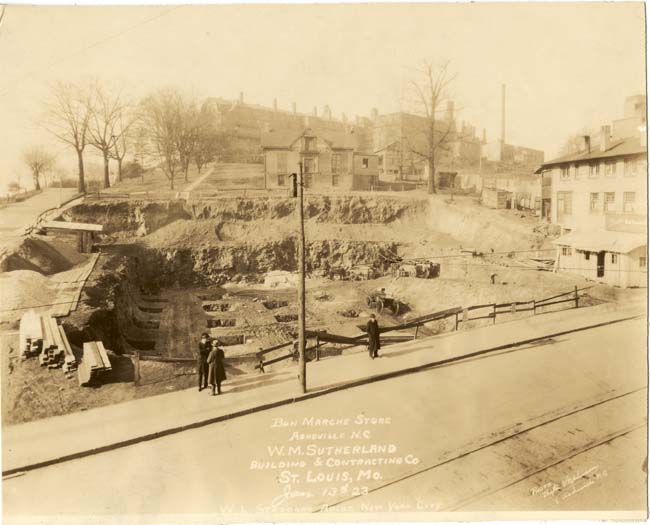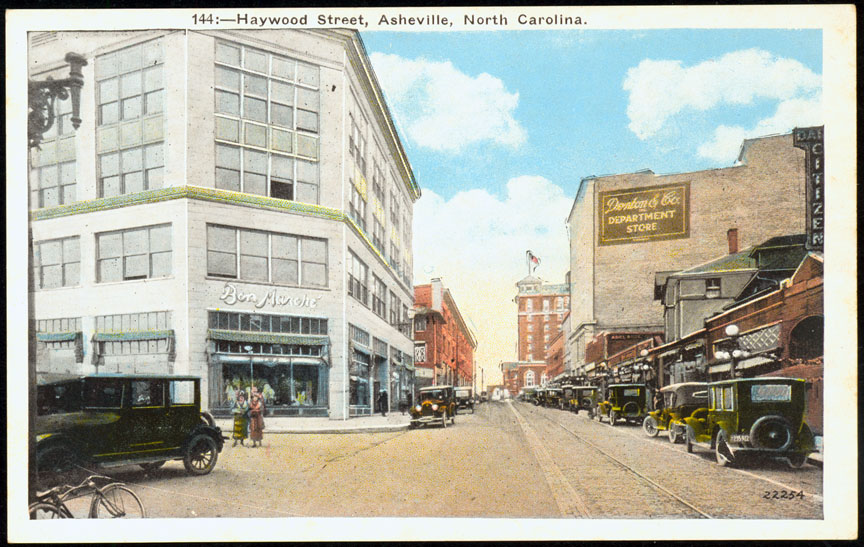Throughout the 1880s, Asheville witnessed plenty. The railroads arrived, Riverside Cemetery was incorporated, electric streetlights shined brightly, the city’s first public schools opened, Mission Hospital formed and, of course, the prominent Jewish businessman Solomon Lipinsky moved to town by way of Tabor.
OK, perhaps Lipinsky’s 1880 arrival didn’t garner the same attention as the other landmark events. (To be fair, he wasn’t prominent just yet.) But his name would soon be known, and his future department store, Bon Marché, would eventually become emblematic of the city’s own downtown growth and progress (as well as its eventual decline).
Lipinsky and his half-sister Eva Ellick opened Bon Marché’s first storefront in 1889. On Oct. 3 of that year The Daily Citizen’s Business and Pleasure column noted the store’s available styles. This included Pearl shirts, along with “the noblest and most fashionable gentlemen’s neckwear, suspenders and gloves.”
When Ellick died in 1893, Lipinsky took over as sole owner (later to be joined by his three sons). The business would relocate several times within its first two decades of operation. But from 1911-23, Bon Marche settled at the former Berkley Hotel on the corner of Patton and Lexington avenues (site of the present-day Kress Building).
On Oct. 9, 1911, The Asheville Citizen reported that the only remaining semblance of the former Berkley Hotel was “the four walls of the building which have housed numerous traveling men and hundreds of tourists.” The roof had been replaced and the interior of all three floors stripped, installing new hardwood maple floors and steel ceilings. Meanwhile, the paper noted, “A telephone exchange with fifteen stations connects the many departments and the electric elevator is doubtless the largest in the city.”
Coverage of the new location continued throughout that year. On Nov. 4, The Asheville Gazette featured an overview of the store’s operations, noting Bon Marché employed roughly 60 people. At times, the breadth of its enterprise appeared to flummox the paper. “There is, for example, department E — hosiery and knit underwear,” the Gazette informed readers. “Sounds simple, yet it requires the work of six people.” Meanwhile, Department K, the article reported, was “nothing but corsets — a corset store.”
By 1922, plans for a new, larger site were underway. The Oct. 16 edition of The Asheville Citizen declared:
“The Bon Marche, S. Lipinsky and Sons, owners, will have one of the finest department stores in the entire State as the result of an agreement with E.W. Grove for the erection of a five-story fireproof building on Haywood Street.”

Construction began in late December. By January 1923, the foundation’s concrete was poured. Early estimates had the building’s completion set for early 1924. But the project would finish ahead of schedule, opening that November. (The building, which still stands today, is now occupied by Haywood Park Hotel and Isa’s Bistro.)
Along with its numerous departments, the new Bon Marché also featured a Public Assembly room, located on its third floor. “Committees, divisions and all bodies of any of the civic organizations are free to use this room, by appointment, at any time they wish,” the Nov. 11 edition of The Sunday Citizen reported.
Three days later, on Nov. 14, the department store held its official dedication. It included a brief address by the city’s mayor, John H. Cathey. The following day’s paper featured the mayor’s remarks. Cathey stated:
“It has been my pleasure since a country boy of 10 years to watch Asheville grow. From an over-grown country village of 35 years ago, with narrow muddy streets, I have seen it develop into what it is today. In contrast to what we had then, we now have miles of paved streets, hundreds of miles of cement walks, a school system second to none in the entire South, a water supply equal to any in the country and churches in keeping with the times.
“As Asheville has grown there has grown with it the Bon Marche. It has kept pace with progress and today we are here to dedicate to the service of the people of our City, a greater Bon Marche, one in keeping with the growth and progress of Western North Carolina[.]”
Lipinsky died on March 28, 1925. The business remained family-owned until the late 1970s. In 1937, Bon Marché relocated its downtown store, moving the business across the street (into present-day Earth Guild). It continued to operate from this location until it closed in 1979.
During this time, the department store also opened two additional locations at the Westgate Shopping Center (1956) and the Asheville Mall (1973). Sold to the Myers-Arnold Co. in 1979, the organization would eliminate the Bon Marché name from both storefronts in 1980.
Editor’s note: Peculiarities of spelling and punctuation are preserved from the original documents.




Are there any members of the Lipinsky family still living? Isn’t there a building named Lipinsky at UNCA?
I am not sure whether anyone bearing the family name still lives in Asheville. Lipinsky Hall, on UNC-A campus, is, I think, an auditorium. Here is a link to some of the Lipinsky family photos in the UNC-A Special Collection relating to Asheville history: http://toto.lib.unca.edu/findingaids/mss/lipinsky/series/photographs_lipinsky.htm
Yes, there are still Lipinskys living in Asheville, although anyone with the Lipinsky last name lives in the Charlotte and Greensboro areas.